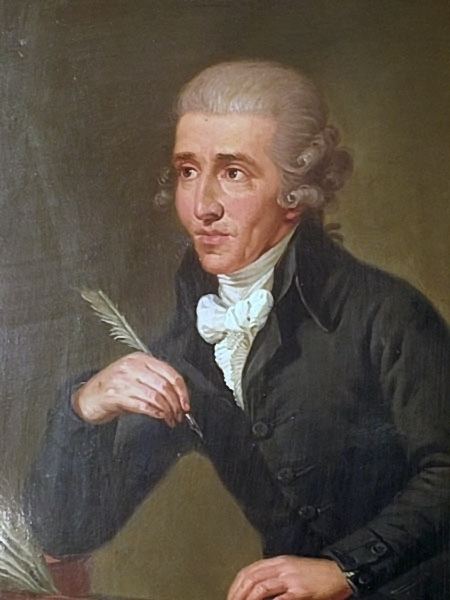 | ||
Joseph Haydn's Autobiographical sketch (1776) is the only autobiographical document ever prepared by this composer. Haydn wrote the sketch, which is about two pages long, at the request (relayed to him by a chain of two mutual acquaintances) of Ignaz de Luca, who was preparing a volume of brief biographies of Austrian luminaries entitled Das gelehrte Oesterreich ("Learned Austria"). The sketch was published in 1778, in Volume 1, Part 3 of this work. At the time of writing Haydn was 44 years old.
Contents
Content
The sketch may be read in its entirety by following the External Link given below.
The sketch begins with a brief account of the first 29 years of Haydn's life. Haydn mentions his early home life in Rohrau, his early education in Hainburg, his subsequent career as a choirboy in Vienna, his struggles during eight years of freelance work, and his appointments as Kapellmeister, first with Count Morzin and then with the hugely wealthy Esterházy family. For a detailed account of this period of Haydn's life, including material from other sources, see Joseph Haydn.
Having related his rise to career success, Haydn says nothing at all of the years 1761-1776 spent working in the Esterházy court, but concludes his narrative with a declaration of loyalty to his employer:
I was engaged as ... Capellmeister of His Highness the Prince Esterházy, in whose service I wish to live and die.Haydn held to his word: despite considerable tedium and loneliness during the time his employer required him to live in isolated Esterháza, he remained in official service to Prince Esterházy and his heirs up to his death in 1809.
The sketch goes on to list what Haydn regarded as his most important works up to that time: the operas Le pescatrici, L'incontro improvviso, and L'infedelta delusa; his oratorio Il Ritorno di Tobia (1775) and his Stabat Mater (1767). All of these are vocal music; Haydn omits pre-1776 instrumental works that arguably have received greater critical acclaim in modern times, such as the "Farewell" Symphony or the string quartets, Opus 20. Musicologist David Schroeder notes that "in the eighteenth century vocal music was considered pre-eminent. With opinion such as this as the common currency, it should not surprise us that Haydn ... listed only vocal works among those he considered his finest."
Haydn also offers an assessment of his then-current reputation as a composer, expressing appreciation for the praise and support of Johann Adolph Hasse, Carl Ditters von Dittersdorf, and Gottfried van Swieten, as well as considerable resentment directed at various (unnamed) critics in Berlin.
I have been fortunate enough to please almost all nations except the Berliners; this is shown by the public newspapers and letters addressed to me. I only wonder that the Berlin gentlemen, who are otherwise so reasonable, preserve no medium in their criticism of my music, for in one weekly paper they praise me to the skies, whilst in another they dash me sixty fathoms deep into the earth, and this without explaining why; I know very well why: because they are incapable of performing some of my works, and are too conceited to take the trouble to understand them properly.The sketch concludes thus:
My highest ambition is only that all the world regard me as the honest man I am.I offer all my praises to Almighty God, for I owe them to Him alone: my sole wish is to offend neither my neighbour, nor my gracious Prince, nor above all our merciful God.The sketch as rhetoric
The musicologist Elaine Sisman has offered a novel interpretation of the sketch as having been written, whether consciously or not, according to principles of rhetoric laid down in the Middle Ages. She notes that Haydn studied Latin as a schoolboy, and that traditional Latin instruction would likely have included the principles of rhetoric. Sisman annotates the sections of Haydn's original letter as follows.
The sketch is a classic rhetorically organized composition, drawing particularly on the medieval ars dictaminis, the art of letter-writing: first an introduction (exordium), incorporating the so-called "securing of good-will" (benevolentiae captatio, in this case by self-deprecation); then the narration of facts (narratio, his biography); the supporting evidence (corraboratio, the list of pieces); the refutation of his enemies' arguments (confutatio, the Berlin critics); and the conclusion, revealing again his good qualities as well as those whom he admires and respects (peroratio).